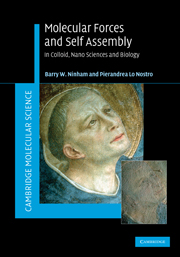Book contents
- Frontmatter
- Contents
- Preface
- Part I Molecular forces
- 1 Reasons for the enquiry
- 2 Different approaches to, and different kinds of, molecular forces
- 3 Electrostatic forces in electrolytes in outline
- 4 The balance of forces
- 5 Quantum mechanical forces in condensed media
- 6 The extension of the Lifshitz theory to include electrolytes and Hofmeister effects
- 7 Specific ion effects
- 8 Effects of dissolved gas and other solutes on hydrophobic interactions
- Part II Self assembly
- Index
- References
3 - Electrostatic forces in electrolytes in outline
from Part I - Molecular forces
Published online by Cambridge University Press: 06 January 2011
- Frontmatter
- Contents
- Preface
- Part I Molecular forces
- 1 Reasons for the enquiry
- 2 Different approaches to, and different kinds of, molecular forces
- 3 Electrostatic forces in electrolytes in outline
- 4 The balance of forces
- 5 Quantum mechanical forces in condensed media
- 6 The extension of the Lifshitz theory to include electrolytes and Hofmeister effects
- 7 Specific ion effects
- 8 Effects of dissolved gas and other solutes on hydrophobic interactions
- Part II Self assembly
- Index
- References
Summary
The assumptions of classical theories
The classical theory of electrolyte solutions starts with the assumption that ionic interactions in solution or between colloid particles are dictated by Coulomb, electrostatic forces alone. An ion is considered to first approximation to have a charge distribution confined to a hard sphere of a given radius. In the ‘primitive’ model the ions are immersed in water (or another solvent) within which they interact by electrostatic interactions. The solvent is treated as a passive dielectric continuum. The radius of an ion is not always just its crystallographic radius. It is an effective radius that includes one or two water layers of ‘hydration’. What occurs in the theory for the free energy of interactions involves the sum of hydrated ion radii besides the Coulomb force. The hydrated ion size is derived as a fitting parameter from comparison of theory with experiments.
For interactions between ions the long-range Coulomb interactions dominate for very dilute solutions below about 5·10−2 M, and ion size is irrelevant. At higher electrolyte concentrations, around and above about 10−1 M, the cooperative electrostatic interactions that dominate at low concentrations become progressively less important. Shorter-range forces subsumed in the ionic ‘radii’ begin to come into play. When short-range interactions between the ions become significant the molecular structure of the water in the immediate neighbourhood of the ions (hydration) becomes a dominant feature. Hydration and local hydrogen bonding are words that attempt to describe this ion-specific, local water structure induced by the ions.
- Type
- Chapter
- Information
- Molecular Forces and Self AssemblyIn Colloid, Nano Sciences and Biology, pp. 35 - 64Publisher: Cambridge University PressPrint publication year: 2010
References
- 2
- Cited by



